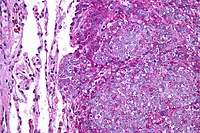
Photo from wikipedia
Introduction Ewing sarcoma (EwS) is the second most common paediatric bone-associated cancer, which may originate from mesenchymal stem cells (MSCs). It is characterised by specific fusion oncogenes involving the EWSR1… Click to show full abstract
Introduction Ewing sarcoma (EwS) is the second most common paediatric bone-associated cancer, which may originate from mesenchymal stem cells (MSCs). It is characterised by specific fusion oncogenes involving the EWSR1 gene and variable members of the ETS family of transcription factors (mostly FLI1). EWSR1-FLI1 is an aberrant transcription factor, which deregulates hundreds of genes via creating de novo enhancers at GGAA-microsatellites. Previous data showed that ectopic EWSR1-FLI1 expression in MSCs induces SOX2. SOX2 is a stem cell marker, whose precise function in EwS remains elusive. Material and methods We employed DNA microarrays, RNA-Seq, ChIP-Seq, qRT-PCR, Western blot, immunohistochemistry, RNA-interference, in vitro and in vivo functional assays. Results and discussions Analysis of gene expression and tissue microarrays revealed that SOX2 is highly expressed only in 15%–20% of EwS tumours. In two cohorts, SOX2-high patients had very poor outcome, which appeared to be independent from typical clinical markers for worse outcome such as age and metastasis. The observed heterogeneity of SOX2 expression was not attributable to differential methylation levels and copy number changes at the SOX2 promoter. However, in cell culture models we found that knockdown of EWSR1-FLI1 in EwS cells reduces SOX2 expression, whereas its ectopic expression in embryonic stem cells up-regulated SOX2. We currently investigate the potential inter-patient variability of EWSR1-FLI1 bound SOX2-regulatory elements such as GGAA-microsatellites, which may explain differential SOX2 expression across EwS tumours. To elucidate the role of SOX2 in EwS, we performed gene-set enrichment analysis of SOX2 co-expressed genes in 117 primary EwS tumours, which indicated that SOX2 may be involved in proliferation, stemness and drug resistance. In agreement, knockdown of SOX2 in EwS cell lines markedly reduced cell proliferation and clonogenic growth in vitro as well as tumour growth in vivo. Using combined RNA-Seq and ChIP-Seq experiments, we identified potential SOX2 targets, which may collectively explain the SOX2 phenotype. We are currently screening a drug library to identify a novel treatment options for SOX2-high EwS patients. Conclusion Taken together, our data suggest that SOX2 is a heterogeneously expressed EWSR1-FLI1 target gene, whose high expression confers an aggressive phenotype, and thus may serve as a biomarker for a high-risk subgroup of EwS patients.
Journal Title: ESMO Open
Year Published: 2018
Link to full text (if available)
Share on Social Media: Sign Up to like & get
recommendations!